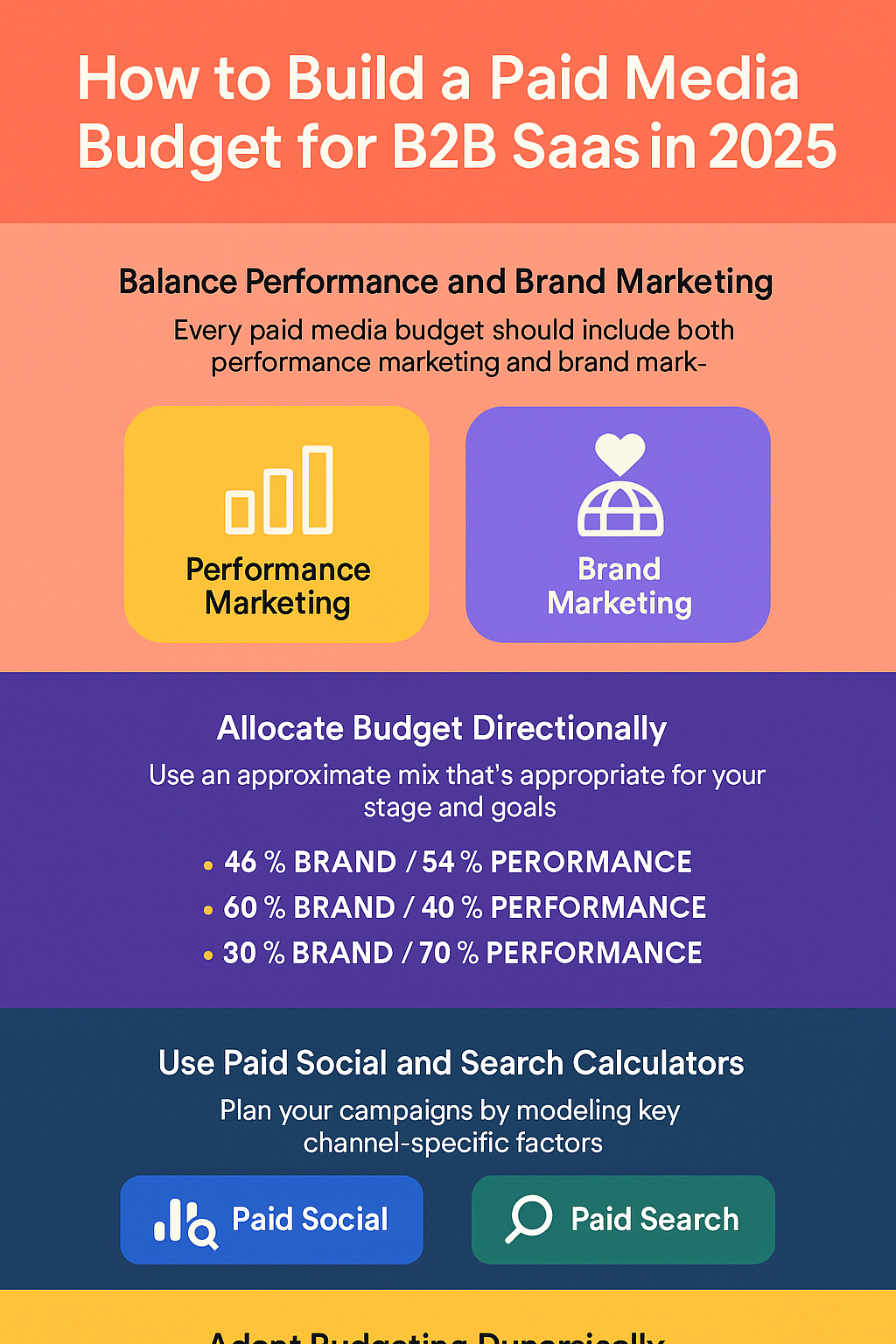If you are a Head of Marketing planning your paid media budget for the rest of 2025, this guide is built for you.
Building an effective paid media budget today requires more than simply plugging numbers into a spreadsheet. It demands a strategic approach that balances performance marketing with brand marketing, accounts for market realities, and adapts dynamically over time.
There is no one-size-fits-all paid media budget template. However, there are frameworks that can dramatically improve your planning accuracy—and more importantly, your results.
This article will walk you through the fundamentals of building a paid media budget for B2B SaaS companies, whether you are working with $350M in ARR or closer to $5–10M ARR.

The Two Primary Paid Media Budget Categories
Before diving into the numbers, it is important to understand that every strong paid media budget has two core components:
- Performance marketing: Spend aimed directly at generating leads, opportunities, and closed-won deals. This is often considered “activation” or “bottom-of-funnel” spend.
- Brand marketing: Spend aimed at growing awareness, credibility, and trust among your target market. Brand marketing nurtures future buyers who are not currently in-market.
Most teams intuitively grasp performance marketing. It is easy to model: “If I spend $10,000, how many leads or deals will I get?”
Brand marketing, by contrast, is harder to model and easier to underinvest in—especially under short-term pressure.
Yet a high-performing paid media budget requires a deliberate allocation to both categories. Neglecting brand marketing restricts your future pipeline and forces you into an endless cycle of harvesting diminishing returns.
What the Benchmarks Say About Paid Media Budget Allocation
Over the years, several well-respected studies and frameworks have recommended split allocations between brand and performance marketing:
- The B2B Institute: 46% brand, 54% activation
- Les Binet and Peter Field: 60% brand, 40% activation for optimal long-term growth
- SaaStr: For early-stage SaaS companies (sub $10M ARR), 30% brand, 70% activation; mid-stage still recommends 30% brand
These benchmarks are helpful starting points, but they are not rigid rules.
The key takeaway:
Allocating 100% of your paid media budget to performance marketing rarely makes sense.
Most of your total addressable market is not actively in-market right now. Brand marketing keeps your company top-of-mind for when they are ready to buy.
How to Directionally Plan Your Paid Media Budget
At Stratus Analytics, we use a straightforward, directional framework when helping B2B SaaS companies plan paid media budgets.
This approach includes:
- Top-down allocation: Setting brand and performance percentages up front
- Channel modeling: Building audience and campaign-specific calculators for paid social and paid search
- Dynamic updates: Using API integrations to adjust budget allocation based on real-time performance
Let us break it down.
Building Your Paid Social Budget Model
Paid social budgets need to account for the realities of platform dynamics, not just historical performance.
Here are the core inputs we use to calculate an initial paid social budget:
- Audience Size: How many people fit your ICP criteria on LinkedIn, Meta, or other platforms?
- Target Reach %: What portion of the audience do you want to reach monthly?
- Target Frequency: How many times per month should a user see your ad?
- Historical CPM: What is your expected cost per thousand impressions?
- CTR: What click-through rate are you anticipating based on creative and offer quality?
- Conversion Rate: How often do clicks convert into meaningful leads or actions?
By inputting these numbers into a paid social calculator, you can figure out:
- Your maximum sustainable monthly spend per audience
- How many impressions, clicks, and conversions you can expect
- Whether you are likely to saturate your audience too quickly
This ensures you are setting your paid media budget based on real platform economics, not arbitrary guesses.
Building Your Paid Search Budget Model
Paid search planning works similarly but with different key inputs:
- Monthly Impressions: How many times your target keywords are searched?
- Target Impression Share: What share of available impressions do you want to capture?
- CPC: Expected cost per click for your keywords
- CTR: Expected click-through rate from search ad impressions
- Conversion Rate: Expected lead or opportunity rate from search traffic
Paid search calculators allow you to determine:
- How much you would need to spend to achieve target share
- Whether your approved budget is sufficient to stay competitive
- Where to prioritize between branded, non-branded, and competitor campaigns
Together, paid search and paid social calculators create a much more precise directional plan for your 2025 paid media budget.
Why Dynamic Budget Reallocation Matters
Building a great initial paid media budget is important.
But maintaining an effective paid media budget over time requires dynamic reallocation.
After launch, performance across platforms and campaigns will shift based on:
- Channel saturation
- Changes in CPMs or CPCs
- Offer effectiveness
- Macro factors like seasonality
That is why we recommend setting up systems that automatically pull spend and performance data via API from each ad platform (Google Ads, LinkedIn Ads, Meta Ads, etc.).
With dynamic dashboards, you can:
- See budget pacing in real time
- Reallocate dollars from underperforming campaigns
- Double down on emerging top performers
- Stay aligned with both spend and pipeline targets
Static budgeting is dead. Adaptive budgeting is how top SaaS brands will win in 2025 and beyond.
Key Takeaways for Your 2025 Paid Media Budget
To wrap up, here are the critical principles to follow when planning your paid media investment:
- Always allocate spend to both brand and performance marketing. Defaulting to performance-only is a trap.
- Use directional benchmarks, but tailor them to your stage, goals, and market dynamics.
- Build paid social and search calculators to ground your planning in platform realities.
- Expect your models to change once campaigns are live—dynamic reallocation is essential.
- Measure brand marketing impact carefully using leading indicators like branded search growth, share of voice, and website traffic quality.
Paid media budgeting is not just a finance exercise. It is a strategic lever that can either accelerate or bottleneck your company’s growth trajectory.
Plan it carefully. Manage it dynamically. And never lose sight of the long-term pipeline you are building.

Hi there! I’m Scott, and I am the principal consultant and thought leader behind Stratus Analytics. I have a Master of Science degree in marketing analytics, and I’ve have been providing freelance digital marketing services for over 20 years. Additionally, I have written several books on marketing which you can find here on Amazon or this website.
DISCLAIMER: Due to my work in the packaging industry, I cannot take on freelance clients within the packaging manufacturing space. I do not want to provide disservice to your vision or my employer. Thank you for understanding.
